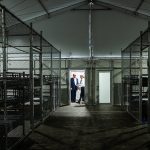Tokyo has clearly sought to downplay the fact that its flattops are aircraft carriers—possibly owing to political sensitivities, as the Japanese military has not operated carriers since World War II.
The Japanese Maritime Self-Defense Force (JMSDF) has been converting its two Izumo-class helicopter destroyers to de facto aircraft carriers—enabling JS Izumo and JS Kaga to operate with the Lockheed Martin F-35B Lightning II, the short takeoff and vertical landing variant of the Joint Strike Fighter. The two flattops will be the first Japanese warships to conduct fixed-wing carrier operations since World War II.
The transitioning of the two warships has received no shortage of media attention, in part because it required Tokyo to undertake a reinterpretation of Article 9 of Japan’s post-war pacifist constitution. That article nominally forbids Japan to declare war, but allows Tokyo to participate in military action in the name of “collective self-defense” on behalf of an ally. Fearing a future confrontation with China, as well as potential aggression from North Korea, Tokyo sought to enhance the capabilities of JMDSF, including the ability to operate with the fifth-generation multi-role F-35B.
The first of those aircraft arrived in Japan last month, with vertical takeoff and landing training underway at the Nyutabaru Air Base in the Miyazaki Prefecture. That training has been met with criticism and even protests from local officials over noise concerns—notably as the Japanese Air Self-Defense Force (JASDF) had announced that there would be as many as 100 vertical landings per month, including upwards of 40 at night.
Plans had called for the training to be conducted on the uninhabited Mage Island, but work on the JASDF’s infrastructure, notably the runways, has yet to be completed. It is unclear when that work will be finished, but will likely not be before 2029 or early 2030—meaning that the residents of Miyazaki will need to face the noise for the time being.
Japan’s Warships Have Received a New Designation
Even as the structural changes to JS Izumo and JS Kaga have yet to be completed, the warships have received a new designation—something that has received far less attention. It was only reported this month by Naval News that the Japanese Ministry of Defense revised the hull classifications, effective last October.
Instead of being designated DDH-183 and DDH-184, respectively, the warships have received the pennant numbers CVM-183 and CVM-184. DDH was the hull classification for “helicopter destroyer,” and last year the ministry added the classification “CVM.”
“At first glance [CVM] appears analogous to US Navy nomenclature and might be read as a ‘multi-purpose aircraft carrier,’” Naval News reported—noting the similarity between CVM and CVN, the US Navy’s designation for an aircraft carrier. “However, the JMSDF Office of Public Affairs says the acronym expands to ‘Cruiser Voler Multipurpose.’”
As the Izumo-class vessels are the largest surface combatants in service with the JMSDF, it was decided that the two vessels would be redesignated as cruisers. Yet, like the US Navy, the “V” is still derived from the French word voler, meaning “to fly,” and has been used in its carrier hull classifications for more than a century.
Tokyo has clearly sought to downplay the fact that its flattops are aircraft carriers—possibly owing to political sensitivities, as the Japanese military has not operated carriers since World War II. The ministry also introduced the hull classification CG, for “Cruiser Guided-missile,” for the first time, which will apply to the JMSDF’s future “Aegis system-equipped vessels” that are expected to enter service later this decade. The US Navy’s cruisers use the same designations.
Carriers or cruisers, it may not matter. For the first time in 80 years, Japan has flattops that can operate with fixed-wing fighters—whatever it wants to call them!
About the Author: Peter Suciu
Peter Suciu has contributed over 3,200 published pieces to more than four dozen magazines and websites over a 30-year career in journalism. He regularly writes about military hardware, firearms history, cybersecurity, politics, and international affairs. Peter is also a contributing writer for Forbes and Clearance Jobs. He is based in Michigan. You can follow him on Twitter: @PeterSuciu. You can email the author: [email protected].
Image: Shutterstock / viper-zero.


















